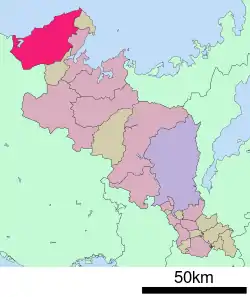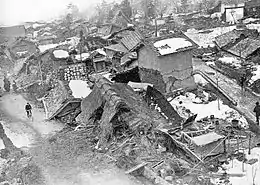Kyōtango
Kyōtango (京丹後市, Kyōtango-shi) is a city located in Kyoto Prefecture, Japan. The modern city of Kyōtango was established on April 1, 2004, from the merger of the towns of Mineyama and Omiya (both from the Naka District), the towns of Amino, Tango, and Yasaka (all from the Takeno District), and the town of Kumihama (from the Kumano District). The Naka, Takeno, and Kumano Districts were dissolved as a result of the merger.
Kyōtango
京丹後市 | |||||||||||
|---|---|---|---|---|---|---|---|---|---|---|---|
 Flag  Emblem | |||||||||||
 Location of Kyōtango in Kyoto Prefecture | |||||||||||
 Kyōtango Location in Japan | |||||||||||
| Coordinates: 35°37′27″N 135°3′40″E | |||||||||||
| Country | Japan | ||||||||||
| Region | Kansai | ||||||||||
| Prefecture | Kyoto Prefecture | ||||||||||
| Government | |||||||||||
| • Mayor | Masanao Misaki (since May 2016) | ||||||||||
| Area | |||||||||||
| • Total | 501.43 km2 (193.60 sq mi) | ||||||||||
| Population (April 1, 2018) | |||||||||||
| • Total | 52,725 | ||||||||||
| • Density | 105/km2 (270/sq mi) | ||||||||||
| Time zone | UTC+09:00 (JST) | ||||||||||
| City hall address | 889 Sugitani, Mineyama-chō, Kyōtango-shi, Kyoto-fu 627-8567 | ||||||||||
| Website | www | ||||||||||
| |||||||||||
Mineyama, now part of Kyōtango, has a close connection with the Hagoromo legend. The Kumihama area is well known for its many hot springs, while Amino is one of the major producers of Tango Chirimen.
The entire area of Kyōtango is in the eastern part of the San'in Kaigan Geopark.
Geography

Located on the coast of the Sea of Japan on the western side of the Tango Peninsula in the northwestern corner of the prefecture, the new city has its city hall in the former town hall of Mineyama.
Demographics
As of April 1, 2018, the city has an estimated population of 52,725[1] and a population density of 105 persons per km². The total area is 501.43 km².
History

The 1927 Kita Tango earthquake caused major damage in the region and killed around 3,000 people.
Notable people
Kyōtango was home to Jiroemon Kimura who was born in the city in 1897. He was the world's oldest living man since April 2011, the oldest living person in Japan since December 2011 and as of December 17, 2012, was the world's oldest verified living person.[2] Kimura lived in Kyōtango his entire life and was said to have recollections of the 1927 earthquake. He spoke of his memories of surviving the earthquake on his 114th birthday.[3] On December 28, 2012, Kimura became the oldest verified man in history, but he died on June 12, 2013.[4]
Other people who were born in, residents of, or otherwise closely associated with Kyōtango include:
- Shinsuke Nakamura (born 1980, in Mineyama), professional wrestling star.[5]
- Kenji Inoue (born 1976, in Amino), bronze medalist for Wrestling at the Summer Olympics in 2004.
- Kyōgoku Takatomi (born 1835), a Japanese daimyō of the late Edo period, who ruled the Mineyama Domain of Tango Province.
- Michiko Shimizu (born 1970, in Amino), retired long-distance runner who mainly competed in the 5000 metres. She finished fourth at the 1996 Summer Olympics in Atlanta.
- Sosuke Takatani (born 1989, in Amino), amateur middleweight freestyle wrestler.
- Yosuke Tagawa (born 1959, in Ōmiya), actor, tarento, and former idol singer.
- Katsuya Nomura (born 1935, in Amino), baseball player and manager.
- Shoko Hamada (born 1986, in Kumihama), tarento, gravure idol, and race queen.
- Unchain, rock band formed in Kyōtango in 1996.
Education
Due to Japan's declining birthrate, the number of children is decreasing, and many schools in Kyōtango have been merged or closed. When Kyōtango was established in 2004, there were thirty-one elementary schools in the city, but as of February 2018 that number had decreased to nineteen.
Senior high schools
Prefectural
- Mineyama High School
- Mineyama High School, Yasaka Branch School
- Amino High School
- Amino High School, Taiza Branch School
- Kumihama High School
Junior high schools
Municipal
- Mineyama Junior High School
- Omiya Junior High School
- Amino Junior High School
- Tango Junior High School
- Yasaka Junior High School
- Kumihama Junior High School
Elementary schools
Municipal
- Mineyama Elementary School
- Isanago Elementary School
- Shinzan Elementary School
- Tanba Elementary School
- Nagaoka Elementary School
- Omiya Dai'ichi Elementary School
- Omiya Minami Elementary School
- Shimazu Elementary School
- Tachibana Elementary School
- Amino Kita Elementary School
- Amino Minami Elementary School
- Toyosaka Elementary School
- Taiza Elementary School
- Ukawa Elementary School
- Yoshino Elementary School
- Yasaka Elementary School
- Kumihama Elementary School
- Kōryū Elementary School
- Kabutoyama Elementary School
Kindergartens
- Mineyama Kindergarten
- Amino Kindergarten
- Tango Kindergarten
Driving schools
- Kyoto Prefectural Mineyama Driving School
- Amino Driving School
Neighbouring municipalities
Military Base
The Japan Air Self-Defense Force maintains a facility in the city (the Kyogamisaki Sub-Base), part of the Basic Air Defense Ground Environment. The Kyogamisaki Communications Site, a USFJ missile monitoring station, is located nearby.
References
- "Official website of Kyoto Prefecture" (in Japanese). Japan: Kyoto Prefecture. Retrieved 11 February 2018.
- http://www.dailyrecord.co.uk/news/uk-world-news/jiroemon-kimura-becomes-worlds-oldest-1495647
- http://asienspiegel.ch/2011/04/der-alteste-mann-der-welt/
- http://www.guinnessworldrecords.com/news/2012/12/japans-jiroemon-kimura-confirmed-as-oldest-living-person-at-115-years-253-days-46484/
- "Archived copy". Archived from the original on 2014-12-25. Retrieved 2016-04-01.CS1 maint: archived copy as title (link)
External links
 Media related to Kyōtango, Kyoto at Wikimedia Commons
Media related to Kyōtango, Kyoto at Wikimedia Commons- Kyōtango City official website (in Japanese)